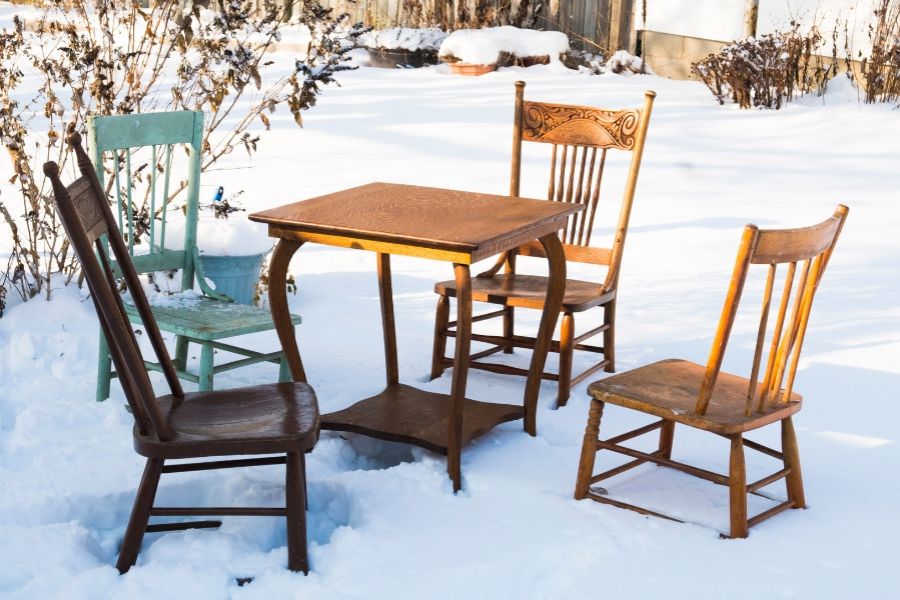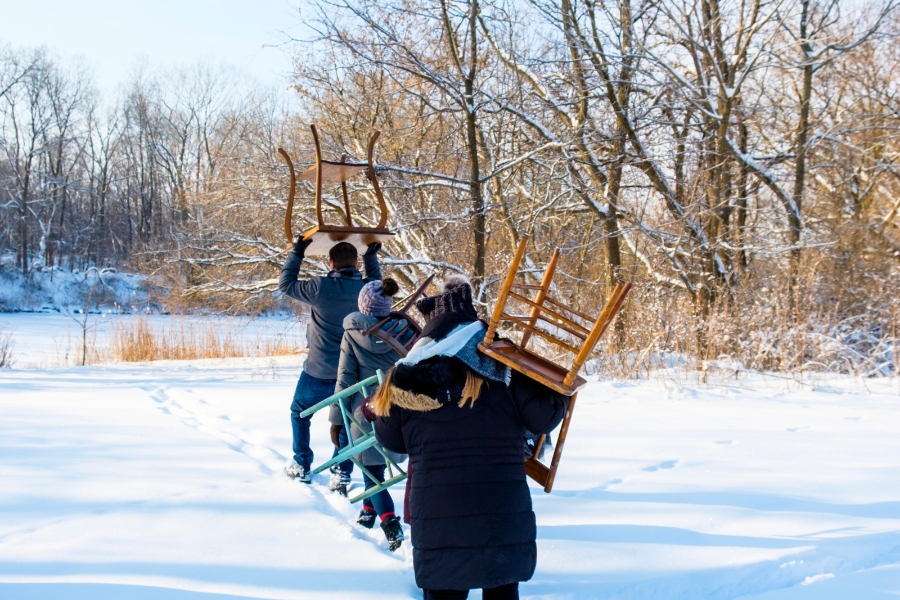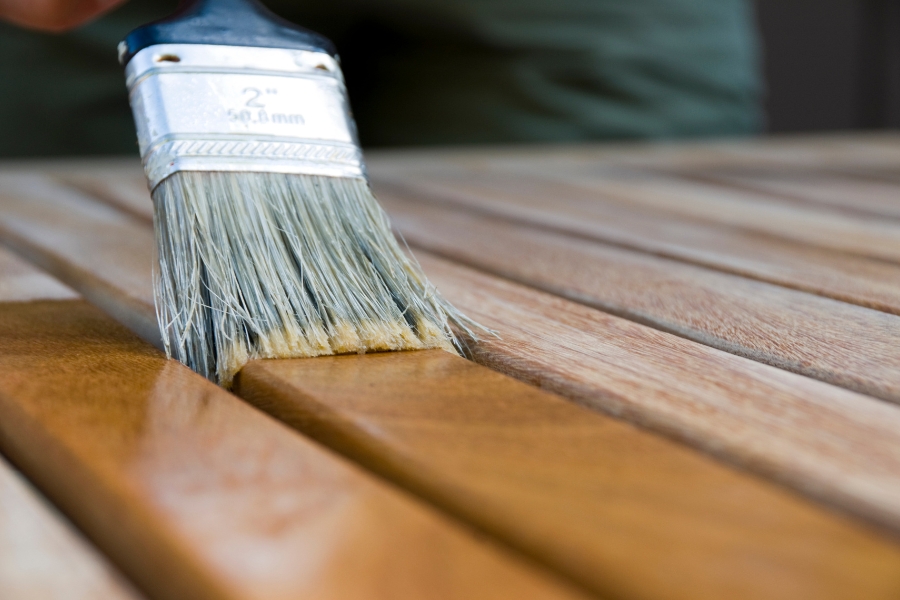
What You Can Do to Protect Wooden Outdoor Furniture From Harsh Winter Weather
With fall already here and winter just around the corner, you should do what you can now to protect wooden outdoor furniture.
Because if you don’t deal with it now, pretty soon it’ll be covered in snow, and that can cause the wood to rot, swell, or crack, among other things, all of which can completely ruin your furniture.
Truth be told, this can be a lot of work, but if you want to preserve outdoor wood furniture, and keep it looking its best for years to come, then there’s just no way around it.
Luckily, there’s a lot you can do to protect wooden outdoor furniture, like covering and storing it, sanding and refinishing it, cleaning it, and more.
But if you’ve never done this sort of thing before, then you might not even know where to begin.
So, if you want to learn about protecting wooden outdoor furniture over the winter, but you don’t know the first thing about it, then you’re definitely going to want to keep reading.
Why Should I Protect Wooden Outdoor Furniture Over the Winter?
Wood is an inherently porous material, which makes it particularly susceptible to the rigors of winter weather.
The combination of moisture, frost, and fluctuating temperatures can severely damage wooden furniture, causing warping, cracking, rotting, and more.
That being said, there are many reasons why you should protect wooden outdoor furniture over the winter months, with most of them being related to the frigid, wet weather.
Winter poses several risks to wooden furniture, including moisture from rain and snow, which can penetrate the wood, causing it to swell and potentially rot.
What’s more, temperature fluctuations can cause the wood to expand and contract, which can create cracks.
Additionally, mould and mildew can grow in moist conditions, and this can significantly degrade the wood, ruining its finish and making it more likely to rot.
Even during the winter, UV rays can still penetrate and degrade the finish on your furniture, leading to discolouration and weakening of the wood.
In any case, understanding these threats is the first step toward effectively protecting wooden outdoor furniture.
And now that you have a better understanding of these threats, let’s talk about what you can do about them.
How Can I Protect Wooden Outdoor Furniture?

Protecting wooden outdoor furniture from harsh winter weather requires a thoughtful and systematic approach.
This includes everything from inspecting, cleaning, repairing, and refinishing to covering, storing, and of course, routine maintenance.
It sounds like a lot of work, and oftentimes it is, but it will allow you to ensure your furniture stays in excellent shape, extending its life for many more seasons of enjoyment.
With that in mind, here’s what you can do to protect wooden outdoor furniture over the winter:
Protective Covers and Storage
Hands down, the most effective way to protect wooden furniture during winter is to store it in a dry, sheltered place like a garage, shed, or basement.
However, this isn’t always possible, so if indoor storage is not an option, then high-quality, waterproof covers can provide sufficient protection.
But make sure that the covers fit each piece of furniture snugly and are designed to allow air circulation, which prevents condensation and mould growth.
And if you choose to store your furniture indoors, remember to place it off the ground on blocks or pallets to prevent moisture from seeping in through the floor.
Cleaning
Whether you’re leaving your furniture outside, or storing it inside, the initial step in preparing your furniture for winter involves a thorough cleaning.
This process removes any accumulated dirt, debris, or growths like moss, mould, and mildew, which can cause deterioration over time.
Start by diluting a small amount of mild soap in a bucket of water. Then, using a soft brush, gently scrub the surfaces of the furniture to remove dirt and grime.
For areas affected by mould or mildew, a mixture of one part vinegar to ten parts water can be used to help kill and remove it.
After scrubbing, rinse the furniture thoroughly with clean water from a garden hose and allow it to dry completely in the sun.
This drying process may take a day or more, depending on weather conditions, but it is vital to ensure that no moisture is trapped in the wood before moving on to the next steps.
Inspection and Repairs
Once the furniture is completely clean and dry, you should conduct a detailed inspection of each piece for signs of damage like cracks, rot, or loose components.
Winter’s harsh conditions can exacerbate existing damage, making this a critical step.
You can use wood glue to secure any loose joints, replace rusted or damaged hardware, and fill small cracks or splits with wood filler and then sand down any rough spots to create a smooth surface.
If the wood’s rotting, first you should assess the extent of the damage.
Minor rot, for instance, can be treated with wood hardener and filler, but if there’s more substantial decay, you may need to replace or repair some parts of the furniture.
Sanding and Refinishing

Applying a new finish to your furniture is something else you should do, as it not only restores its appearance but also adds a protective layer against moisture and cold, which is perfect for winter.
Begin by lightly sanding the furniture with medium-grit sandpaper to remove the old finish and create a smooth surface.
If you plan to paint the wood, first apply a coat of primer designed for outdoor use, and once the primer has dried, apply an outdoor paint or stain in the colour of your choice.
And if you want the best protection for outdoor wood furniture, you should select a product that includes a waterproofing agent.
Finally, make sure to apply a waterproof sealant, covering all surfaces thoroughly, as it provides a robust barrier against moisture, UV rays, and temperature fluctuations.
Routine Maintenance
Even during the winter, it’s important to check on your furniture every now and then, especially if it’s stored outdoors.
Whatever the case, make sure to remove the coverings on your furniture every few weeks to check for any signs of moisture or mould.
At this point, you can also clean off any debris or water that may have collected on the covers or furniture and adjust the positioning of the furniture or the tightness of the covers as needed to ensure ongoing protection.
Additional Tips
Aside from everything we’ve already mentioned, there are a few other things you can do to protect wooden outdoor furniture.
One thing you might want to consider is using moisture absorbers in closed spaces like sheds to help keep the air dry, which further protects the wood.
If your furniture is left outside during the winter, make sure that the legs of the furniture aren’t in direct contact with soil or grass, as this can cause the wood to rot.
And for certain types of wood, such as teak or cedar, applying a moisture-repelling oil or wax can help to enhance their natural water-resistant properties.
Looking for a carpenter in Kelowna to create custom-made wooden furniture?
Our master woodworker, Andy Ingram, has over 30 years of experience. For more details, contact us or check out our portfolio to see what we’re capable of creating.